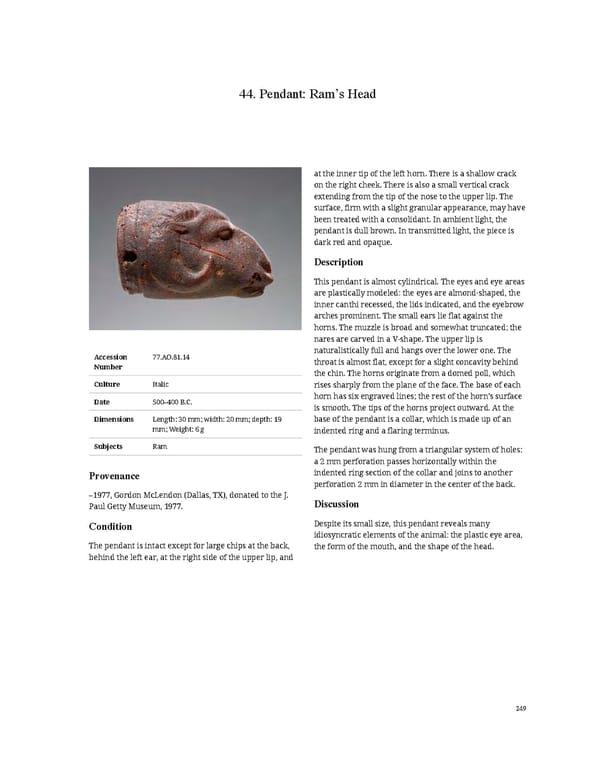44. Pendant: Ram’s Head at the inner tip of the left horn. There is a shallow crack on the right cheek. There is also a small vertical crack extending from the tip of the nose to the upper lip. The surface, firm with a slight granular appearance, may have been treated with a consolidant. In ambient light, the pendant is dull brown. In transmitted light, the piece is dark red and opaque. Description This pendant is almost cylindrical. The eyes and eye areas are plastically modeled: the eyes are almond-shaped, the inner canthi recessed, the lids indicated, and the eyebrow arches prominent. The small ears lie flat against the horns. The muzzle is broad and somewhat truncated; the nares are carved in a V-shape. The upper lip is Accession 77.AO.81.14 naturalistically full and hangs over the lower one. The Number throat is almost flat, except for a slight concavity behind the chin. The horns originate from a domed poll, which Culture Italic rises sharply from the plane of the face. The base of each Date 500–400 B.C. horn has six engraved lines; the rest of the horn’s surface is smooth. The tips of the horns project outward. At the Dimensions Length: 30 mm; width: 20 mm; depth: 19 base of the pendant is a collar, which is made up of an mm; Weight: 6 g indented ring and a flaring terminus. Subjects Ram The pendant was hung from a triangular system of holes: a 2 mm perforation passes horizontally within the Provenance indented ring section of the collar and joins to another perforation 2 mm in diameter in the center of the back. –1977, Gordon McLendon (Dallas, TX), donated to the J. Discussion Paul Getty Museum, 1977. Condition Despite its small size, this pendant reveals many idiosyncratic elements of the animal: the plastic eye area, The pendant is intact except for large chips at the back, the form of the mouth, and the shape of the head. behind the left ear, at the right side of the upper lip, and 249
 Ancient Carved Ambers in the J. Paul Getty Museum Page 258 Page 260
Ancient Carved Ambers in the J. Paul Getty Museum Page 258 Page 260